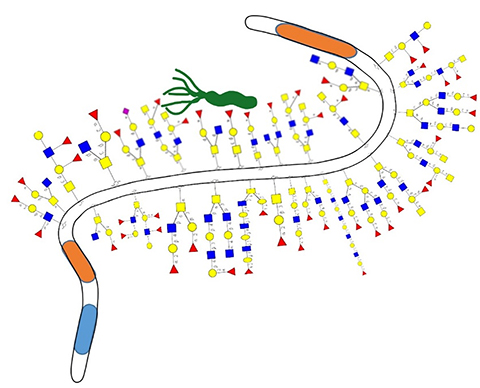How mucus keeps us healthy
We tend to associate mucus with colds and flu, but its role in the body is complex and varied. This colloidal network of salts, enzymes, antibodies, glycans and glycoproteins is found in the nose, mouth, lungs, stomach, intestines and reproductive tract. The slimy mucus layer of the stomach includes bottle brush–shaped glycoproteins called mucins that contain carbohydrate chains called glycans that help build a selective, viscous barrier between epithelial cells and the external environment.
Sara Lindén at the University of Gothenburg in Sweden studies interactions between microbes and mucosal surfaces in the stomach, intestine and airways. “Until relatively recently many researchers thought the role of the glycans on the mucins was merely to hold water and thereby create a lubricating barrier on our mucosal surfaces,” Lindén said. “Recently, a number of studies have shown that the mucin glycans have roles in binding to and governing interactions with microbes, including both the natural commensal microflora and disease-causing microbes.”

Helicobacter pylori is a common bacteria that can cause harmful infection. Spread through contaminated drinking water, poor sanitation and saliva sharing, it might be present in as much as 50% of the world’s population. Most people are unaffected, but some experience stomach pain and develop ulcers. Chronic infection can lead to certain stomach cancers, and many strains of H. pylori are now antibiotic resistant.
Lindén’s doctoral studies involved H. pylori interactions in the human stomach, and she has continued this line of research. A recent article in the journal Molecular & Cellular Proteomics reports on novel glycan structures her team found in mucin from stomach samples of individuals with and without H. pyloriinfection.
The lab’s previous studies showed people benefit from mucins that bind efficiently to Helicobacter, as this limits the bacteria that come into contact with human cells and cause disease. Proteins on the H. pylori surface called adhesins bind to surface structures on the cell, Lindén explained. “Mucins can also bind to these adhesins and act as releasable decoys that Helicobacter can bind to instead of the human cell.”
Lindén and her team were surprised at the diversity they found in over 600 carbohydrate structures identified from just 28 patient samples. Patients infected with H. pylori showed larger interpatient variability in this diversity than noninfected patients. In this context, Lindén said, “The high diversity of glycans suggests that interactions with microbes in the stomach can vary enormously between different individuals.”
Previous experiments in animals have shown that H. pyloriinfection and mucin production are cyclically related: Infection leads to decreased mucin production as well as changes in the mucin glycosylation, allowing more H. pylori to bind cells and infect. In this study, Lindén’s team found specific structures that correlated particularly well to H. pylori binding.
All this could inform the design of glycan-based therapeutics as an alternative to the standard use of multiple antibiotics. Gurdeep Chahal, lead author of this article, imagines that “targeting the H. pylori adhesins with the analogues of these glycans could reduce the bacterial colonization in the stomach while simultaneously treating chronic gastritis.”
Lindén sees the results going further: “The work presented here shows how structures in the human body differ between individuals and how this affects interactions with a pathogen … part of a larger concept of understanding how our body surfaces defend themselves against disease causing microorganisms and how we can enhance these defense systems to treat and prevent infections without antibiotics.”
Enjoy reading ASBMB Today?
Become a member to receive the print edition four times a year and the digital edition monthly.
Learn moreGet the latest from ASBMB Today
Enter your email address, and we’ll send you a weekly email with recent articles, interviews and more.
Latest in Science
Science highlights or most popular articles

The science of staying strong
Muscles power every movement, but they also tell the story of aging itself. Scientists are uncovering how strength fades, why some species resist it and what lifestyle and molecular clues could help preserve muscle health for life.

Bacteriophage protein could make queso fresco safer
Researchers characterized the structure and function of PlyP100, a bacteriophage protein that shows promise as a food-safe antimicrobial for preventing Listeria monocytogenes growth in fresh cheeses.

Building the blueprint to block HIV
Wesley Sundquist will present his work on the HIV capsid and revolutionary drug, Lenacapavir, at the ASBMB Annual Meeting, March 7–10, in Maryland.

Gut microbes hijack cancer pathway in high-fat diets
Researchers at the Feinstein Institutes for Medical Research found that a high-fat diet increases ammonia-producing bacteria in the gut microbiome of mice, which in turn disrupts TGF-β signaling and promotes colorectal cancer.

Mapping fentanyl’s cellular footprint
Using a new imaging method, researchers at State University of New York at Buffalo traced fentanyl’s effects inside brain immune cells, revealing how the drug alters lipid droplets, pointing to new paths for addiction diagnostics.

Designing life’s building blocks with AI
Tanja Kortemme, a professor at the University of California, San Francisco, will discuss her research using computational biology to engineer proteins at the 2026 ASBMB Annual Meeting.

